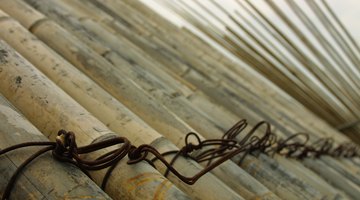What Is the Difference Between Carmelized and Carbonized Bamboo?
Bamboo is a green building material with excellent strength and versatility. It can be used for a wide variety of applications, from a cooking utensil, to fencing, flooring and furniture. The speed of bamboo growth makes it an excellent renewable resource that can be replaced rapidly.

Untreated bamboo is an almost white wood with attractive grain and texture. When it is carbonized, the color turns caramel-like and deepens.
Bamboo Wood
Bamboo wood is increasingly popular due to its beauty and strength. It is a hollow stem with extremely hard wood on the exterior, which grows straight and true. Bamboo can be harvested numerous times and will produce a usable crop in a fraction of the time it takes a tree to mature for harvest. Unlike a tree, the bamboo will come back from its rhizomes and roots if it is cut back. Bamboo's strength can be accented by heat-treating. Using a blowtorch enhances its natural strength, making it similar to steel.
Carbonized Bamboo
Carbonizing is done in a lengthy steaming process. This method brings out the coloring and makes the grain deepen to stand out more than untreated bamboo. The process does tend to weaken the wood. The resulting wood can be scratched more easily than un-carbonized bamboo. The high heat of the steam breaks apart some of the plant fibers, which results in a pliable material with slightly less hardness. The wood can be weakened by as much as 20 to 30 percent.
Caramelized Bamboo
For caramelization, the heating process with steam is done to a lesser extent on whiter bamboo. This process brings out the sugars in the bamboo, thus caramelizing them to create a honey color. Plants use sugars as food, which come from the photosynthesis process where the bamboo uses carbon dioxide and water harvested from the air and solar energy to convert the two compounds into sugar and oxygen. Sugar is caramelized by bringing it to the boiling point and changing the molecules. Caramel sauce comes from just such a process. After bamboo is caramelized, it is dried in a kiln.
Types of Carbonized Flooring
There are both vertical and horizontal carbonized plywoods, which are found in flooring and furniture. Carbonized flooring should not be used in areas with heavy foot traffic because of its reduced strength. The wood must have a protective coating applied on top of it and be completely sealed to prevent moisture from getting into the grain. Carmelized bamboo is glued together in strips, and the flooring is laminated. Then the product is milled and planked for specific applications. The vertical and horizontal carbonized planks are made by applying the slats in certain directions during the gluing process.
References
Writer Bio
Bonnie Grant began writing professionally in 1990. She has been published on various websites, specializing in garden-related instructional articles. Grant recently earned a Bachelor of Arts in business management with a hospitality focus from South Seattle Community College.
Photo Credits
- Photos.com/Photos.com/Getty Images
- Photos.com/Photos.com/Getty Images
More Articles



